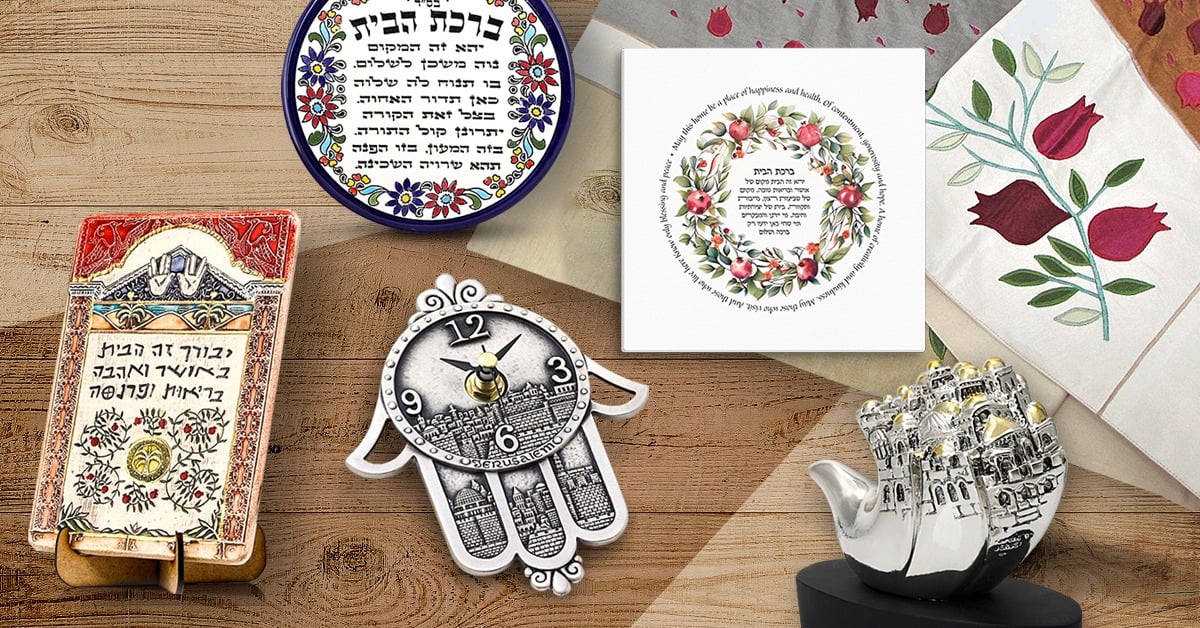
Looking for ways to make your home a Jewish home?
Here are the top 7 customs for home décor from Jewish tradition, used by Jewish communities around the world for generations!
Keeping a Hamsa amulet in one’s home is a Middle Eastern and North African tradition that goes back centuries, and while not exclusively Jewish, it's found in many Jewish homes around the world even today. It's a symbol of Divine protection, and often believed to bring luck, happiness, and harmony into the home while safeguarding from negative energies and the "evil eye."
For many Jews today, the Hamsa is also a symbol of their Jewish identity and connection to their heritage.
The symbol is depicted as an open right hand, often with an eye in the center of the palm. The hand can either be pointing up or down, fingers spread or close together.
The Hamsa is one of the most popular symbols used by Israeli artists on Jewish home décor, beloved by Jews everywhere and hung in homes all over the world!
The Hebrew Bible is our most foundational Jewish text and has therefore always inspired the Jewish imagination, including our artists and designers - and Jews have always loved to adorn our homes with meaningful items that reference powerful Biblical stories, themes, and verses.
From wall art to sculptures to Judaica, there are all kinds of Biblical home décor featuring meaningful themes from our Scriptures with which to decorate a Jewish home - whether featuring beautiful pomegranates or other Biblical Seven Species, the 10 Commandments, the 12 Tribes of Israel, Tree of Life imagery, or other Biblical motifs.
Whether you're looking for a meaningful gift for a loved one or to express your own faith, there's nothing more special than Biblical décor!
There is a Jewish tradition of putting up “house blessings” or “home blessings” – works of art featuring a Jewish blessing or quote from Scriptures, calling for Divine protection and for positive attributes to be placed on the home and its inhabitants, such as happiness, success, peace, love, luck, and abundance.
Home blessings may be simple or elaborately artistic, and today they may be written in Hebrew, English, or both. They're often given as housewarming gifts and traditionally hung up upon moving in, but can also be added to one's home décor anytime!
Many Jewish families put up Jerusalem-themed art and home décor around their homes, such as a painting of the Old City or the famous quote from Psalms, “If I Forget Thee O Jerusalem.”
This tradition is a beautiful way to bring a touch of Jerusalem into one’s life, and to always have a reminder of the Land of Israel and the Jewish people’s origins no matter where one lives. And Jerusalem décor also makes for a traditional and unforgettable housewarming or holiday gift for a loved one!
A beautiful tradition found all over Israel, and in some Jewish homes in the diaspora, is the family name plaque or door sign.
These are decorated ceramic or wooden pieces of art hung on a front door or gate, featuring the last name of the family who resides there, or sometimes listing all names of the inhabitants. These plaques often feature special Jewish symbolism like a Tree of Life or pomegranates, and are a meaningful way of showing off one's heritage!
Every Jewish home needs mezuzahs on its doors – not just according to tradition but per a Biblical commandment as well. A mezuzah consists of an outer case, often beautifully decorated, and a mezuzah parchment scroll containing Biblical verses. It is also believed that the mezuzah bestows blessing and protection on the home and anyone who passes it.
Many Jewish families take the tradition of putting up mezuzahs around the home as an opportunity to also showcase their style and sense of Jewish pride, with gorgeous artistic mezuzah cases made by talented artists.
More than just Judaica, a mezuzah can be a beautiful and meaningful piece of Jewish home décor that your family will treasure for years to come!
Last but not least, countless Jewish families throughout the generations have adorned their homes by proudly displaying their beloved pieces of Judaica.
From Hanukkah menorahs that grace shelves and mantelpieces when not in use, to Passover Seder plates and Rosh Hashanah plates displayed in glass cabinets year-round, to beautiful Shabbat candlesticks and Kiddush cups in their own prominent place in the home - Judaica makes for truly meaningful pieces of home décor!
Ready to make your home a Jewish home? Shop Jewish home decor straight from Israel here, and be sure to check out our best-of guide here!


Owned by JWG Ltd, maintains its offices and warehouse in Jerusalem, Israel. © 1999-2022 JWG Judaica and Dead Sea Cosmetics